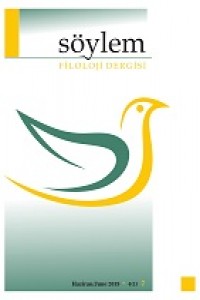Abstract
The
data in the oldest sources about the Turks belong to the Chinese, for this
reason, the ideas related to oldest Turkish words and terms can be interpreted
based on the figures in Chinese annual. One of the important problems of
Turcology is that the obscurity of how the words written with Chinese spelling
in Chinese sources are actually in Turkish. In order to solve the problem, it
may be possible to reach various analyzes and to establish various equivalents
based on the pronunciations of Turkish words in Chinese. The book entitled with
Uighur-Chinese Idikut Dictionary is prepared by the Ming Dynasty Translation
Room in 15th century and it is one of the principal works that can contribute
to the studies on this subject.
The
writing of the dictionary was initiated in 1382 together with the Hu-i-iu (a
comparative dictionary of Chinese and other languages) by the chamber of
interpreters established with the order of Chu Yüan-chang, the first emperor of
the Ming Dynasty. The work has four copies in Beijing, four in Japan and seven
in Europe and Amiot, Klaproth, Ligeti, Hu Chên-hua and Huang Jun-hua, Paul
Pelliot, F. K. Müller and Mağfiret Kemal Yunusoğlu has worked on it. Yunusoglu's
work is a comparative publication of dictionary’s copies. In the text that has
various examinations about spelling, sound, form, vocabulary with reference to the
Old Uighur material, there are explanations, text and index sections, but not a
section for aforementioned problem. In this study, a database based on
equivalences was created depending on Chinese spelling of Old Uighur words in
Yunusoğlu’s work; and then the sound events based on these equivalences were
determined. This study deals with one of these vocal phenomena, the consonant
fall and shows the examples of the changes in Turkish words in Chinese
pronunciation.
References
- Fidan, Giray (2011a). Çin Dili ve Çince Dilbilgisi. (1. Basım). Ankara: Efil Yayınevi.
- Fidan, Giray (2011b). Kanuni Devrinde Çin’de Osmanlı Tüfeği ve Osmanlılar. (1. Basım). İstanbul: Yeditepe Yayınevi.
- Gürsoy-Naskali, Emine (1997). Türk Dünyası Gramer Terimleri Sözlüğü. Ankara: Türk Dil Kurumu Yayınları.
- İmer, Kamile, Kocaman, Ahmet ve Sumru Özsoy (2011). Dilbilim Sözlüğü. İstanbul: Boğaziçi Üniversitesi Yayınları.
- Korkmaz, Zeynep (1992). Gramer Terimleri Sözlüğü. Ankara: Türk Dil Kurumu Yayınları.
- Mathews, R. H. (1975). Chinese-English Dictionary. Cambridge - Massachusetts: Harvard University Press.
- Yunusoğlu, Mağfiret Kemal (2012). Uygurca-Çince İdikut Sözlüğü. Ankara: Türk Dil Kurumu Yayınları.
Abstract
Türklerle
ilgili en eski kaynaklardaki veriler, Çinlilere ait olup, Türkçe kelime ve
terimlerle ilgili ancak Çin yıllıklarındaki şekillerinden hareketle fikir
yürütülebilmektedir. Çin kaynaklarında Çin imlasıyla geçen kelimelerin Türkçede
aslında nasıl olduğunun kesin olarak bilinememesi, Türkolojinin önemli
problemlerinden biridir. Problemin çözülebilmesi için Türkçe kelimelerin
Çincedeki telaffuzlarından yola çıkılarak, çeşitli analizlere ulaşmak ve
çeşitli denklikler kurmak mümkün olabilir. Bu konudaki çalışmalara katkıda
bulunabilecek eserlerin başında Uygurca-Çince
İdikut Sözlüğü adıyla kitaplaştırılan ve XIV. yüzyılda Ming Hanedanı
Tercüme Odası tarafından hazırlanan sözlüktür.
Sözlüğün
yazımı Ming sülalesinin ilk imparatoru Chu
Yüan-chang’in emriyle tercümanlar odası kurularak, Hu-i-i-yü (Çin dilleri ile beraber diğer dillerin karşılaştırmalı
sözlüğü) ile beraber 1382 yılında başlatılmıştır. Eserin Pekin’de dört,
Japonya’da dört, Avrupa’da yedi nüshası bulunup, sözlük üzerinde Amiot,
Klaproth, Ligeti, Hu Chên-hua ve Huang Jun-hua, Paul Pelliot, F. K. Müller ve
Mağfiret Kemal Yunusoğlu çalışmıştır. Yunusoğlu’nun çalışması sözlüğün
nüshalarının karşılaştırmalı bir yayınıdır. Sözlükteki Eski Uygurca malzemeden
hareketle imla, ses, şekil, söz varlığı incelemeleri yapılan eserde
açıklamalar, metin ve dizin bölümleri de yer almakta; yukarıda bahsedilen
probleme yönelik bir bölüme yer verilmemektedir. Bu çalışmada Yunusoğlu
neşrindeki Eski Uygurca kelimelerin Çincedeki imlası esas alınmak suretiyle
denkliklere dayalı bir veri tabanı oluşturulmuş; ardından da bu denklikler
esaslı ses olayları tespit edilmiştir. Bu çalışma, işte bu ses olaylarından
birini, ünsüz düşmesi hadisesini ele almakta ve Türkçe kelimelerin Çincede
söylenirken ne tür değişikliklere uğradığını/uğrayabileceğini örneklerle
göstermektedir.
References
- Fidan, Giray (2011a). Çin Dili ve Çince Dilbilgisi. (1. Basım). Ankara: Efil Yayınevi.
- Fidan, Giray (2011b). Kanuni Devrinde Çin’de Osmanlı Tüfeği ve Osmanlılar. (1. Basım). İstanbul: Yeditepe Yayınevi.
- Gürsoy-Naskali, Emine (1997). Türk Dünyası Gramer Terimleri Sözlüğü. Ankara: Türk Dil Kurumu Yayınları.
- İmer, Kamile, Kocaman, Ahmet ve Sumru Özsoy (2011). Dilbilim Sözlüğü. İstanbul: Boğaziçi Üniversitesi Yayınları.
- Korkmaz, Zeynep (1992). Gramer Terimleri Sözlüğü. Ankara: Türk Dil Kurumu Yayınları.
- Mathews, R. H. (1975). Chinese-English Dictionary. Cambridge - Massachusetts: Harvard University Press.
- Yunusoğlu, Mağfiret Kemal (2012). Uygurca-Çince İdikut Sözlüğü. Ankara: Türk Dil Kurumu Yayınları.
Details
| Primary Language | Turkish |
|---|---|
| Subjects | Linguistics |
| Journal Section | Research Article |
| Authors | |
| Publication Date | June 30, 2019 |
| Submission Date | March 30, 2019 |
| Acceptance Date | June 12, 2019 |
| Published in Issue | Year 2019 Volume: 4 Issue: 1 |

This work is licensed under a Creative Commons Attribution-NonCommercial-NoDerivatives 4.0 International License.

